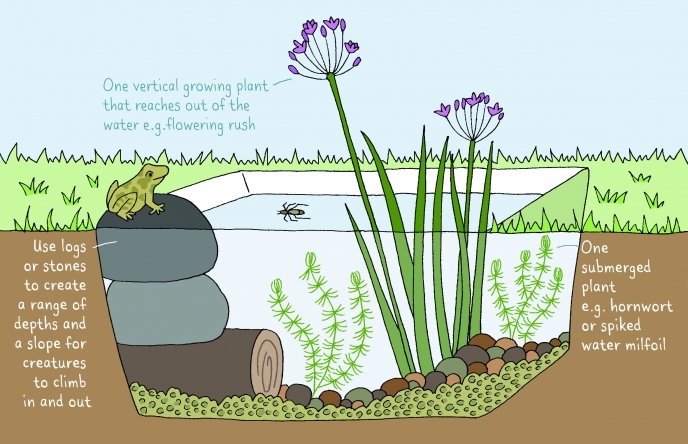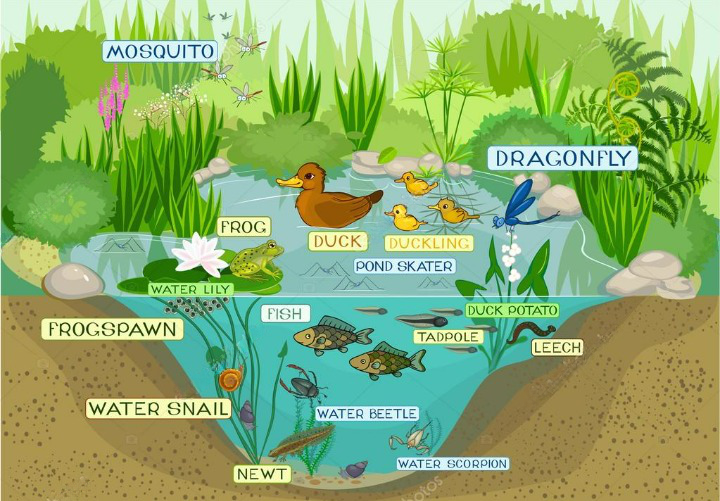DIY Garden Pond Construction Instructions
The tranquility and peace of nature cannot be matched by any other activity. A garden pond might be the ideal place to find peace and quiet in your own backyard, what with its placid waters and vibrant environment. A well-designed pond can enhance your outdoor space while also providing a safe habitat for native flora and fauna.
Building a tranquil haven like this is not only a worthwhile endeavor, but also a fun one that will leave you feeling accomplished. However, it’s simpler to say than execute some things.

That’s why, in this in-depth tutorial, we cover every step of building your own beautiful garden pond. Even if you have never planted a garden before, you should be able to follow the procedures outlined in the article below and create the garden of your dreams.
Our manual will help you with every step of the process, from picking the right spot to picking the right aquatic plants and fish. Keep reading to find out how to make your garden into a beautiful oasis!
Table of Contents
Think Carefully About Where You Want to Put Your Pond

The placement of a garden pond is crucial to its success. Choosing the right location for your aquatic refuge is crucial to its success.
If you want your plants to thrive, you should put them in a location that gets at least four to six hours of sunlight per day. However, you should keep the pond out of places where it will be exposed to direct sunlight for lengthy periods of time, as this could promote an overabundance of algae.
Overhanging trees should be avoided as well, as their dropping leaves might block the pond and cause ecological disruption.
Finally, pick a spot that’s convenient for you, so you can simply tend to it often and bask in its calming ambiance.
Find the Optimal Depth and Width
Consider your budget, the size of your yard, and the kinds of plants and animals you hope to attract when deciding on the ideal measurements for your garden pond. Larger ponds provide for more plant and animal variety, but they also take more time, money, and effort to maintain. Although smaller ponds are less work, they may not support as many species of fish and other aquatic organisms.

Most garden ponds don’t need to be any deeper than 18 to 24 inches. However, a depth of at least 4 feet is recommended to safeguard fish from predators and temperature changes, especially Koi.
Fish species more adapted to a shallow or small pond include those that are smaller overall. Smaller ponds can accommodate a variety of fish species, including goldfish, mosquito fish, red shiners, and common minnows. Because of their resilience and adaptability, these species are great options for a thriving garden pond even when space and depth are limited.
Define the Pond’s Boundaries, then Dig It Out
Mark the pond’s boundaries with rope or spray paint once you’ve settled on the ideal location and measurements. This plan will help you visualize where the pond will go into your garden’s overall design and serve as a visual guide for excavation.
Before digging can begin, the pond’s perimeter must be cleared of grass, weeds, and any other impediments. You can excavate your pond by hand using shovels and spades, or you can employ an excavator for a more substantial undertaking.
Keep the pond’s depth constant and the bottom level as you dig to guarantee the best possible water circulation. Any topsoil you remove should be saved for later use in landscaping or gardening, since it contains a wealth of useful nutrients.
Put in a Strong Liner for the Pond
If you want your garden pond to last for years to come, you need a robust liner to avoid water leaking. Think about using a high-quality, bendable material like EPDM or PVC for your liner. These materials are well-known for their longevity, resistance to puncturing, and adaptability to a wide range of environmental conditions.
Inspect the pond bed for any sharp objects like pebbles or roots that could damage the liner and remove them before installing the liner. To further safeguard the liner, a 1-2 inch layer of sand or underlayment fabric should be laid around the pond’s base.
Carefully unfold the liner and drape it over the pond once the site has been prepped. You should take your time and make sure it fits snugly into the nooks and crannies of your pond’s shelves, ledges, and other special features.
Species of Flora and Fauna

Choosing the right aquatic plants and fish species will improve the health of your pond’s ecosystem and add to its aesthetic appeal. Include submerged, floating, and marginal plants in your landscape design to add visual appeal, enhance water quality, and give wildlife a safe place to live.
When possible, it’s preferable to use native aquatic plants because they require less upkeep, thrive in the local environment, and contribute to the health of local ecosystems. If you want to know what native plants might do well in your yard, you should ask around at local garden clubs and nurseries.
Size differences between species, water conditions, and predators are all things to think about when deciding which fish to add to your pond. Koi and goldfish are common choices, but it’s important to make sure your pond is big enough and deep enough for them to thrive.
Concluding Remarks
Building a pond in your backyard can be an intimidating task at first. However, with forethought and careful execution, you can make your backyard the envy of the neighborhood, with a haven that is both beautiful and practical.
This detailed manual has given me advice on where to put my pond, how big it should be, how deep it should be, how to dig it out, how to put in a liner, and what kinds of plants and animals I should put in it. Following these instructions, even a novice gardener has a good chance of producing a beautiful and productive aquatic haven.
As you go out on this enriching adventure, keep an open mind, practice patience, and be willing to take cues from nature. Your garden pond, if given time and attention, can develop into a tranquil oasis that you can enjoy for many years to come.




